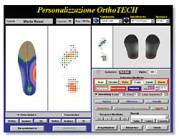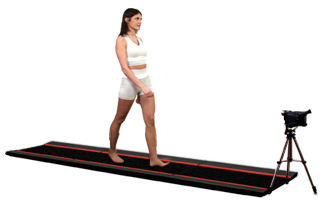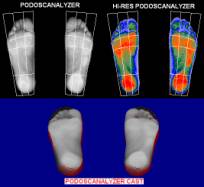|
 Physical Gait System is a sophisticated, non-invasive diagnostic system of digital pressure scanning of feet. It is the only device that has been developed up to the phase of manufacture among comparable devices for the detection of information and pressure distribution on the soles of the foot used in the Czech Republic. During the manufacturing phase, a numerically controlled cutter is used to cut a high-quality individualized orthopedic insole. Using independent modules, the system enables detection and analysis of pressure on the sole of the foot through static and dynamic methods, examination and evaluation of the stability and study of the morphology of the body and gait. All three modules form a biopostural test, enabling comprehensive evaluation of the patient's condition in terms of his/her stability in the gravitation field, or level of dizziness (vertigo symptom), posture, length of extremities, and so on.
Physical Gait System is a sophisticated, non-invasive diagnostic system of digital pressure scanning of feet. It is the only device that has been developed up to the phase of manufacture among comparable devices for the detection of information and pressure distribution on the soles of the foot used in the Czech Republic. During the manufacturing phase, a numerically controlled cutter is used to cut a high-quality individualized orthopedic insole. Using independent modules, the system enables detection and analysis of pressure on the sole of the foot through static and dynamic methods, examination and evaluation of the stability and study of the morphology of the body and gait. All three modules form a biopostural test, enabling comprehensive evaluation of the patient's condition in terms of his/her stability in the gravitation field, or level of dizziness (vertigo symptom), posture, length of extremities, and so on.
The biopostural test comprises: · Pressure scanning of the feet, during which the load on the feet is evaluated and a pressure map of the soles of the feet are obtained, including numerical imaging of the load in the respective points. Data is detected in a 1200 mm long treadmill with 4,800 pressure sensors (static test) and under movement (dynamic test). Comparison of both these tests enables the evaluation of differences in the length of lower extremities, to reveal sliding friction when rolling the leg, which is undesirable especially in patients with diabetic foot syndrome, to compare the actual pressure map of a patient with the standards for a healthy foot, or as the case may be, with previous examinations of the same patient. This test, especially its dynamic part, can also be used for the fabrication of plantar orthosis (orhtopedic insoles) in a related device comprising numerically guided cutter. Based on the pressure scanning, the system generates an orthopedic insole with an even distribution of pressures, which is variably correctible by inserting pre-set orthopedic-prosthetic elements and by manual modeling of the areas on the sole of foot, which can be height-adjusted (reduction of load on overloaded places and prominent bones of foot, support of the fallen longitudinal and transversal arches, supination and pronation support, compensation of an uneven length of the lower extremities (up to 1.5 cm, and so on). The cutting of the insole, unlike older technologies of casting, enables the layering of materials according to the requirements for strength (ShA), which further increases the therapeutic/correction effects and patient's comfort. 
· A stabilometric test is used to obtain data on the movement of the center of gravity with the eyes opened and closed (the following parameters are recorded: length of the trajectory of the center of gravity, area of the trajectory of the center of gravity and mean direction of the balance vector). Evaluation of these tests enables the quantitative assessment of the synergy of the three subsystems, which play a role in the control of the direct posture of the human body (vestibular, visual and somatosensoric) and based thereupon to decide further examinations.

·A morphologic test, which includes the image system, enables the tracking of the dynamics of a step on a video recording along with the digital pressure scanning. Optical and pressure scanning phasing of the records provides information on the sliding friction and position of the lower extremities.
 Foot pressure analyzer (podoscanalyzer) enables the evaluation of the foot morphology and the level of flat foot. Outputs from this analyzer can be used for the design of orthopedic insoles as supportive information enabling to control the projection of pressure points into the design of the insole. The last phase of the morphologic test is Body analysis kapture (BAK), an analysis of the body posture, during which reflex markers located all over the patient's body are detected by one, two, or preferably four video cameras. Evaluation of these 4 images (anterior, posterior, lateral, contralateral) provides basic coordinates of the body (deviation of angles between the individual parts of the body, distance at the site of differences) and the final values are analyzed in the table form. Foot pressure analyzer (podoscanalyzer) enables the evaluation of the foot morphology and the level of flat foot. Outputs from this analyzer can be used for the design of orthopedic insoles as supportive information enabling to control the projection of pressure points into the design of the insole. The last phase of the morphologic test is Body analysis kapture (BAK), an analysis of the body posture, during which reflex markers located all over the patient's body are detected by one, two, or preferably four video cameras. Evaluation of these 4 images (anterior, posterior, lateral, contralateral) provides basic coordinates of the body (deviation of angles between the individual parts of the body, distance at the site of differences) and the final values are analyzed in the table form. Digital pressure scanning is increasingly employed both in the orthopedic/prosthetic practice and during diagnostic medical procedures. From our point of view, we can most use those modules that enable the design and manufacture of strictly individual orthopedic insoles as an effective therapeutic/correction and preventive technique. The advantages of these two methods have been used both by exposed social and professional groups and by elite athletes. | 
